Demand Forecasting for Heavy-Duty Diesel Engines Considering Emission Regulations
Abstract
:1. Introduction
2. Related Literature
2.1. Technology Diffusion Model
2.2. HDDE Emission Regulations
- NOx limits: 8.0 g/kWh in EURO 1, 7.0 g/kWh in EURO 2, 5.0 g/kWh in EURO 3, 3.5 g/kWh in EURO 4, 2.0 g/kWh in EURO 5, and 0.4 g/kWh in EURO 6.
- CO limits: 4.5 g/kWh in EURO 1, 4.0 g/kWh in EURO 2, 2.1 g/kWh in EURO 3, and 1.5 g/kWh in EURO 4–6.
- HC limits: 1.1 g/kWh in EURO 1–2, 0.66 g/kWh in EURO 3, 0.46 g/kWh in EURO 4–5, and 0.13 g/kWh in EURO 6.
- PM limits: 0.61 g/kWh in EURO 1, 0.15 g/kWh in EURO 2, 0.13 g/kWh in EURO 3, 0.02 g/kWh in EURO 4–5, and 0.01 g/kWh in EURO 6.
3. New Model
3.1. HDDE Sales Data
3.2. Proposed Model
- is the i-th generation’s sales at time t;
- is the fraction of the ultimate potential of the i-th generation that has been adopted at time t;
- is the probability distribution function of adoption time t of the i-th generation;
- is the market’s maximum sales per unit life period of the i-th generation;
- is the introduction time of the i-th generation;
- t is the accumulated quarter from ;
- p is the coefficient of innovation; and
- q is the coefficient of imitation.
- is the fraction of the ultimate potential of the i-th generation technology that has decreased due to the attraction of the (i + 1)-th generation technology at time t before the (i + 1)-th generation technology release date;
- is the quarter in which news of the regulation requiring the (i + 1)-th generation technology is released;
- is the phase-out quarter of the i-th generation technology due to the regulation;
- is the inverse of the degree of expected attraction of the (i + 1)-th generation technology; and
- is the market share of the company’s i-th generation product.
- is the time when the regulation associated with the i-th generation is imposed;
- is the portion of consumed at time t;
- is the discount rate for the i-th generation product;
- is a sensitivity parameter of the sales price; and
- is the promotion period.
3.3. Scenario Analysis
4. Conclusions
Acknowledgments
Author Contributions
Conflicts of Interest
References
- Degraeve, Z.; Koopman, G.J. Achieving air quality standards in the European Union. Oper. Res. 1998, 46, 643–654. [Google Scholar] [CrossRef]
- Hirota, K. Comparative studies on vehicle related policies for air pollution reduction in ten Asian countries. Sustainability 2010, 2, 145–162. [Google Scholar] [CrossRef]
- Sohn, S.Y.; Jeon, J.; Han, E.J. A new cost of ownership model for the acquisition of technology complying with environmental regulations. J. Clean. Prod. 2015, 100, 269–277. [Google Scholar] [CrossRef]
- Su, B.; Ang, B.W. Multi-region comparisons of emission performance: The structural decomposition analysis approach. Ecol. Indic. 2016, 67, 78–87. [Google Scholar] [CrossRef]
- Zeng, S.; Chen, J. Forecasting the Allocation Ratio of Carbon Emission Allowance Currency for 2020 and 2030 in China. Sustainability 2016, 8, 650. [Google Scholar] [CrossRef]
- Zeng, S.; Hu, M.; Su, B. Research on investment efficiency and policy recommendations for the culture industry of China based on a three-stage DEA. Sustainability 2016, 8, 324. [Google Scholar] [CrossRef]
- Chen, R.H. Effects of green operations and green innovation on firm’s environmental performance. Ind. Eng. Manag. Syst. 2014, 13, 118–128. [Google Scholar] [CrossRef]
- Brijesh, P.; Sreedhara, S. Exhaust emissions and its control methods in compression ignition engines: A review. Int. J. Automot. Technol. 2013, 14, 195–206. [Google Scholar] [CrossRef]
- Jiang, W.; Liu, J.; Liu, X. Impact of Carbon Quota Allocation Mechanism on Emissions Trading: An Agent-Based Simulation. Sustainability 2016, 8, 826. [Google Scholar] [CrossRef]
- Lou, G.X.; Xia, H.Y.; Zhang, J.Q.; Fan, T.J. Investment strategy of emission-reduction technology in a supply chain. Sustainability 2015, 7, 10684–10708. [Google Scholar] [CrossRef]
- Norton, J.A.; Bass, F.M. A Diffusion Theory Model of Adoption and Substitution for Successive Generations of High-Technology Products. Manag. Sci. 1987, 33, 1069–1086. [Google Scholar] [CrossRef]
- Speece, M.W.; Maclachlan, D.L. Application of a Multi-Generation Diffusion Model to Milk Container Technology. Technol. Forecast. Soc. Chang. 1995, 49, 281–295. [Google Scholar] [CrossRef]
- Mansfield, E. Technical Change and the Rate of Imitation. Econometrica 1961, 29, 741–766. [Google Scholar] [CrossRef]
- Floyd, A. A Methodology for Trend Forecasting of Figures of Merit. In Technological Forecasting for Industry and Government: Methods and Applications; Bright, J., Ed.; Prentice-Hall: Englewood Cliffs, NJ, USA, 1968; pp. 95–109. [Google Scholar]
- Bass, F.M. Comments on “A New Product Growth for Model Consumer Durables”: The Bass Model. Manag. Sci. 2004, 50, 1833–1840. [Google Scholar] [CrossRef]
- Fisher, J.C.; Pry, R.H. A Simple Substitution Model for Technological Change. Technol. Forecast. Soc. Chang. 1971, 2, 75–88. [Google Scholar] [CrossRef]
- Blackman, A.W. A Mathematical Model for Trend Forecasts. Technol. Forecast. Soc. Chang. 1971, 3, 441–452. [Google Scholar] [CrossRef]
- Sharif, M.N.; Kabir, C. A generalized model for forecasting technological substitution. Technol. Forecast. Soc. Chang. 1976, 8, 353–364. [Google Scholar] [CrossRef]
- Chun, S.Y.; Hahn, M. A diffusion model for products with indirect network externalities. J. Forecast. 2008, 27, 357–370. [Google Scholar] [CrossRef]
- Rogers, E. Diffusion of Innovations; Free Press: New York, NY, USA, 1962. [Google Scholar]
- Mahajan, V.; Muller, E.; Bass, F.M. New Product Diffusion Models in Marketing: A Review and Directions for Research. J. Mark. 1990, 54, 1–26. [Google Scholar] [CrossRef]
- Dodds, W. An Application of the Bass Model in Long-Term New Product Forecasting. J. Mark. Res. 1973, 10, 308–311. [Google Scholar] [CrossRef]
- Tigert, D.; Farivar, B. The Bass New Product Growth Model: A Sensitivity Analysis for a High Technology Product. J. Mark. 1981, 45, 81–90. [Google Scholar] [CrossRef]
- Easingwood, C.J.; Mahajan, V.; Muller, E. A Nonuniform Influence Innovation Diffusion Model of New Product Acceptance. Mark. Sci. 1983, 2, 273–295. [Google Scholar] [CrossRef]
- Meade, N.; Islam, T. Modelling and forecasting the diffusion of innovation—A 25-year review. Int. J. Forecast. 2006, 22, 519–545. [Google Scholar] [CrossRef]
- Sohn, S.Y.; Ahn, B.J. Multigeneration diffusion model for economic assessment of new technology. Technol. Forecast. Soc. Chang. 2003, 70, 251–264. [Google Scholar] [CrossRef]
- Islam, T.; Meade, N. The diffusion of successive generations of a technology: A more general model. Technol. Forecast. Soc. Chang. 1997, 56, 49–60. [Google Scholar] [CrossRef]
- Krishnan, T.V.; Bass, F.M.; Kumar, V. Impact of a Late Entrant on the Diffusion of a New Product/Service. J. Mark. Res. 2000, 37, 269–278. [Google Scholar] [CrossRef]
- Becker, T.A.; Sidhu, I.; Tenderich, B. Electric Vehicles in the United States: A New Model with Forecasts to 2030; Center for Entrepreneurship & Technology (CET) Technical Brief, University of California: Berkeley, CA, USA, 2009. [Google Scholar]
- Bass, F.M. A New Product Growth for Model Consumer Durables. Manag. Sci. 1969, 15, 215–227. [Google Scholar] [CrossRef]
- Lamberson, P.J. The Diffusion of Hybrid Electric Vehicles; Center for the Study of Complex Systems, University of Michigan: Ann Arbor, MI, USA, 2009. [Google Scholar]
- Park, S.Y.; Kim, J.W.; Lee, D.H. Development of a market penetration forecasting model for Hydrogen Fuel Cell Vehicles considering infrastructure and cost reduction effects. Energy Policy 2011, 39, 3307–3315. [Google Scholar] [CrossRef]
- Qian, L.; Soopramanien, D. Using diffusion models to forecast market size in emerging markets with applications to the Chinese car market. J. Bus. Res. 2014, 67, 1226–1232. [Google Scholar] [CrossRef]
- Qian, L.; Soopramanien, D. Incorporating heterogeneity to forecast the demand of new products in emerging markets: Green cars in China. Technol. Forecast. Soc. Chang. 2015, 91, 33–46. [Google Scholar] [CrossRef]
- Cummins Inc. Mobile Off-Highway Emissions: Choosing the Right Technology for TIER 4; Cummins Inc.: Columbus, IN, USA, 2009. [Google Scholar]
- Klimont, Z.; Cofala, J.; Schopp, W.; Amann, M.; Streets, D.G.; Ichikawa, Y.; Fujita, S. Projections of SO2, NOx, NH3 and VOC emissions in East Asia up to 2030. Water Air Soil Pollut. 2001, 130, 193–198. [Google Scholar] [CrossRef]
- Resitoglu, I.A.; Altinisik, K.; Keskin, A. The pollutant emissions from diesel-engine vehicles and exhaust aftertreatment systems. Clean Technol. Environ. Policy 2015, 17, 15–27. [Google Scholar] [CrossRef]
- Johnson, T. Diesel Emission Control in Review. SAE Int. J. Fuels Lubr. 2009, 1, 68–81. [Google Scholar] [CrossRef]
- Ligterink, N.; de Lange, R.; Vermeulen, R.; Dekker, H. On-Road NOx Emissions of Euro-V Trucks; Tech. Report, Report MON-RPT-033-DTS-2009-03840; TNO Science and Industry: Delft, The Netherlands, 2009. [Google Scholar]
- Padmanabhan, V.; Bass, F.M. Optimal pricing of successive generations of product advances. Int. J. Res. Mark. 1993, 10, 185–207. [Google Scholar] [CrossRef]
- Kim, J.; Lee, D.; Ahn, J. A dynamic competition analysis on the Korean mobile phone market using competitive diffusion model. Comput. Ind. Eng. 2006, 51, 174–182. [Google Scholar] [CrossRef]
- Zhang, C.; Song, P.; Xu, Y.; Xue, L. Understanding Dynamic Competitive Technology Diffusion in Electronic Markets, Designing E-Business Systems. Mark. Serv. Netw. 2009, 22, 14–24. [Google Scholar]
- Song, P.; Zhang, C.; Xu, Y.; Xue, L.; Wang, K.; Zhang, C. Asymmetric Interaction in Competitive Internet Technology Diffusion: Implications for the Competition between Local and Multinational Online Vendors. J. Glob. Inf. Manag. 2011, 19, 45–64. [Google Scholar] [CrossRef]
- Cronin, J.J., Jr.; Taylor, S.A. Measuring Service Quality: A Reexamination and Extension. J. Mark. 1992, 56, 55–68. [Google Scholar] [CrossRef]
- Anderson, E.W.; Fornell, C.; Lehmann, D.R. Customer Satisfaction, Market Share, and Profitability: Findings from Sweden. J. Mark. 1994, 58, 53–66. [Google Scholar] [CrossRef]
- Li, K.; Lin, B. Impact of energy conservation policies on the green productivity in China’s manufacturing sector: Evidence from a three-stage DEA model. Appl. Energy 2016, 168, 351–363. [Google Scholar] [CrossRef]
- Meng, F.; Su, B.; Thomson, E.; Zhou, D.; Zhou, P. Measuring China’s regional energy and carbon emission efficiency with DEA models: A survey. Appl. Energy 2016, 183, 1–21. [Google Scholar] [CrossRef]
- Zeng, S.; Xu, Y.; Wang, L.; Chen, J.; Li, Q. Forecasting the Allocative Efficiency of Carbon Emission Allowance Financial Assets in China at the Provincial Level in 2020. Energies 2016, 9, 329. [Google Scholar] [CrossRef]
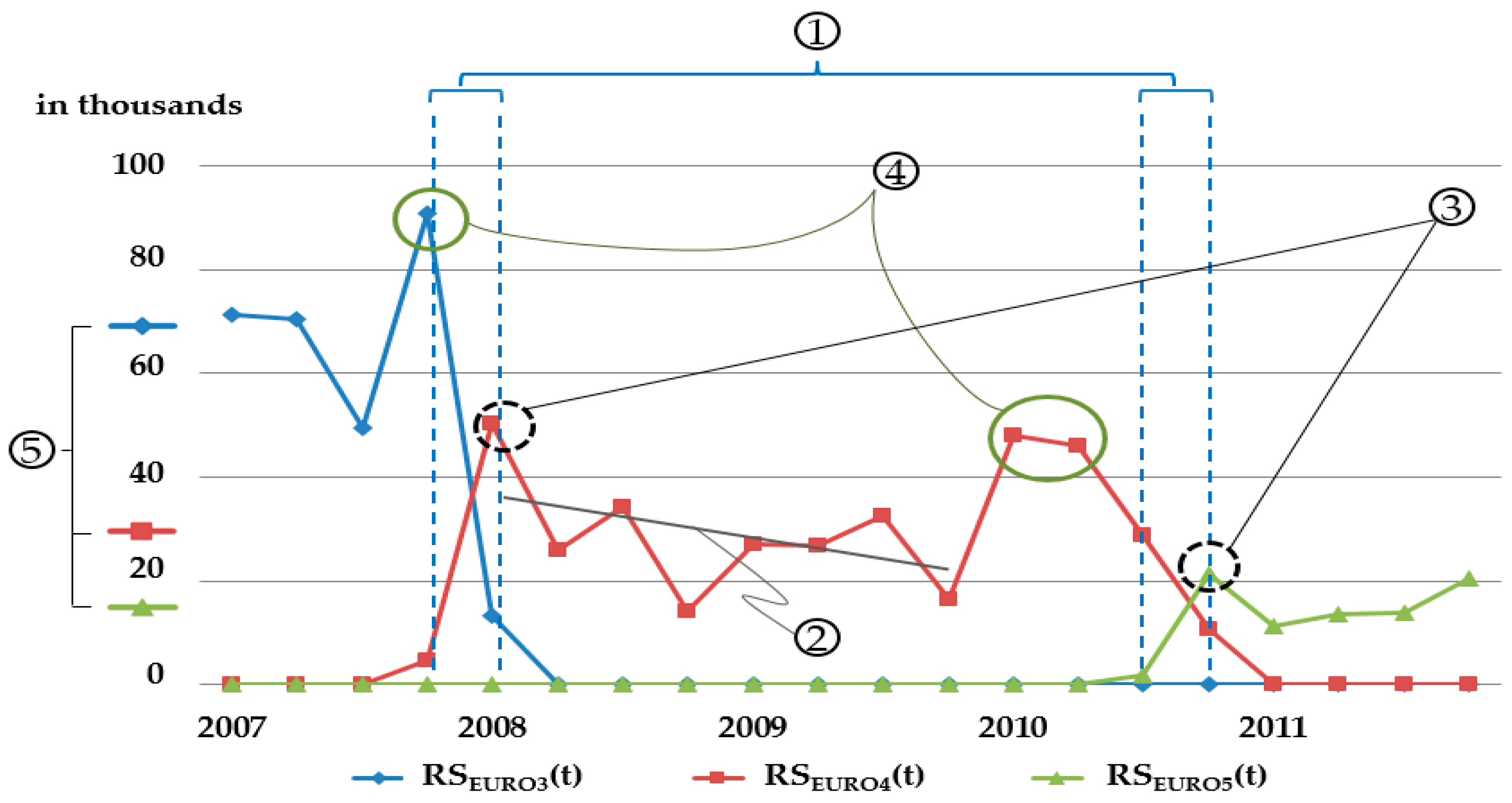

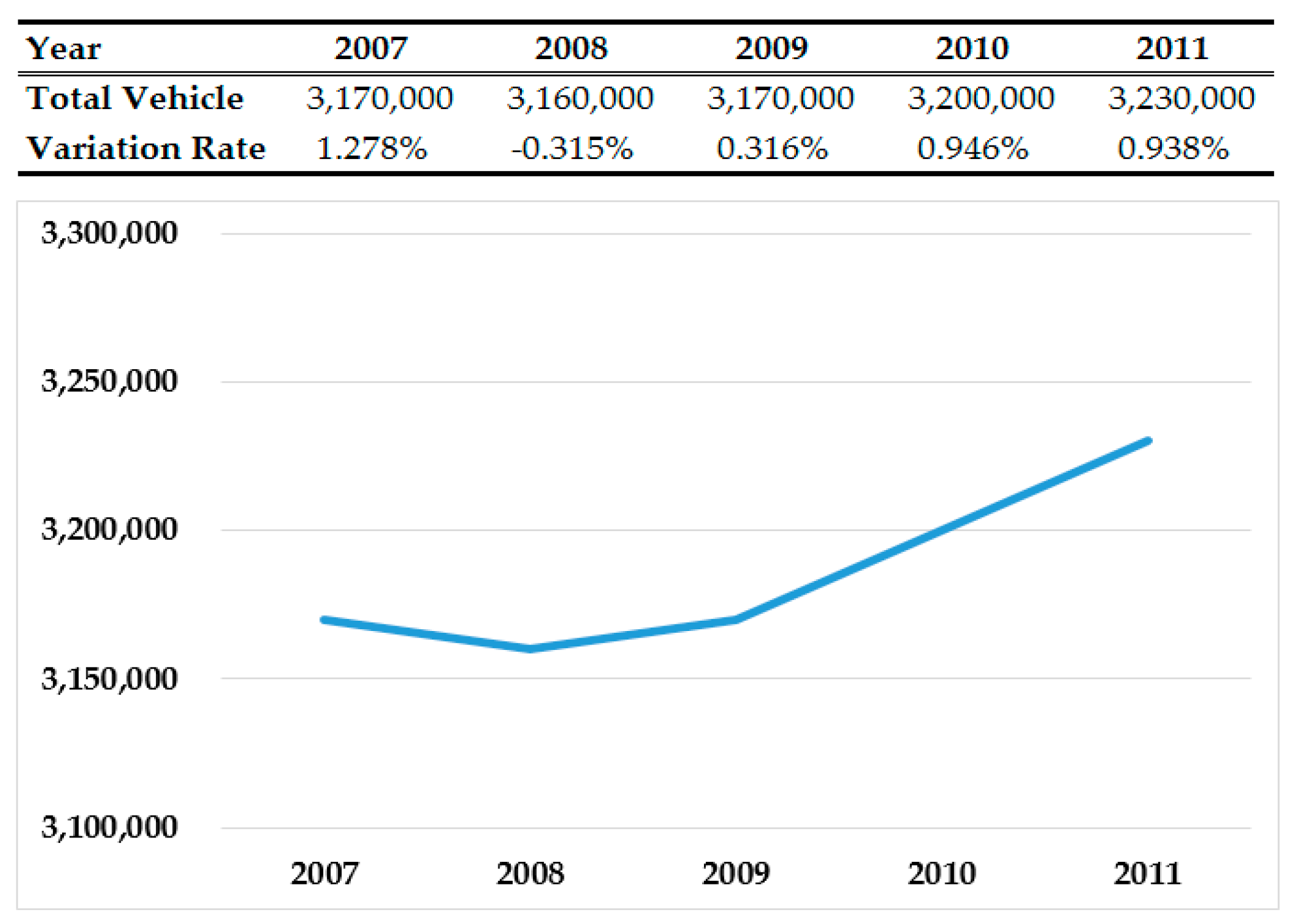

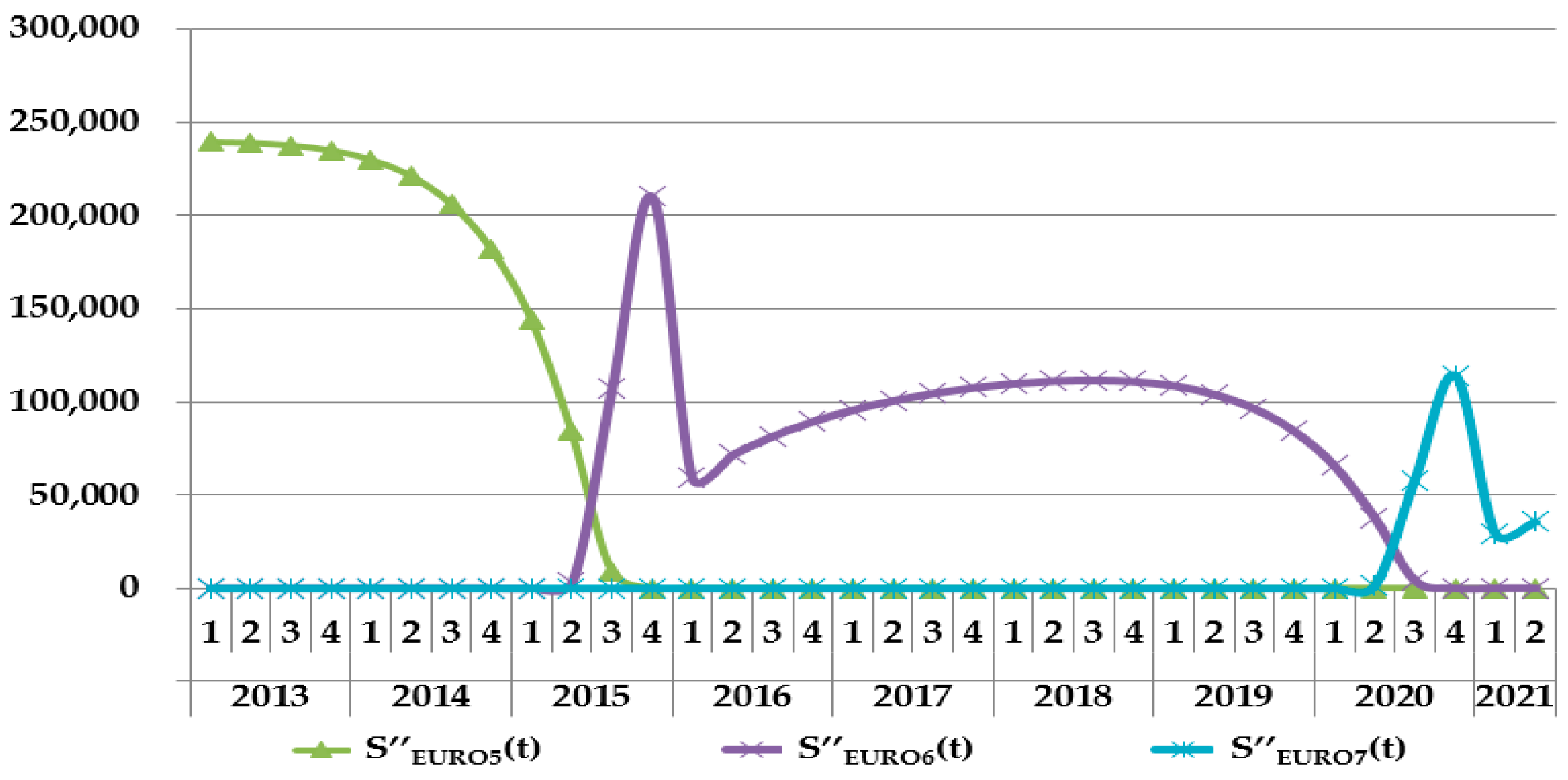
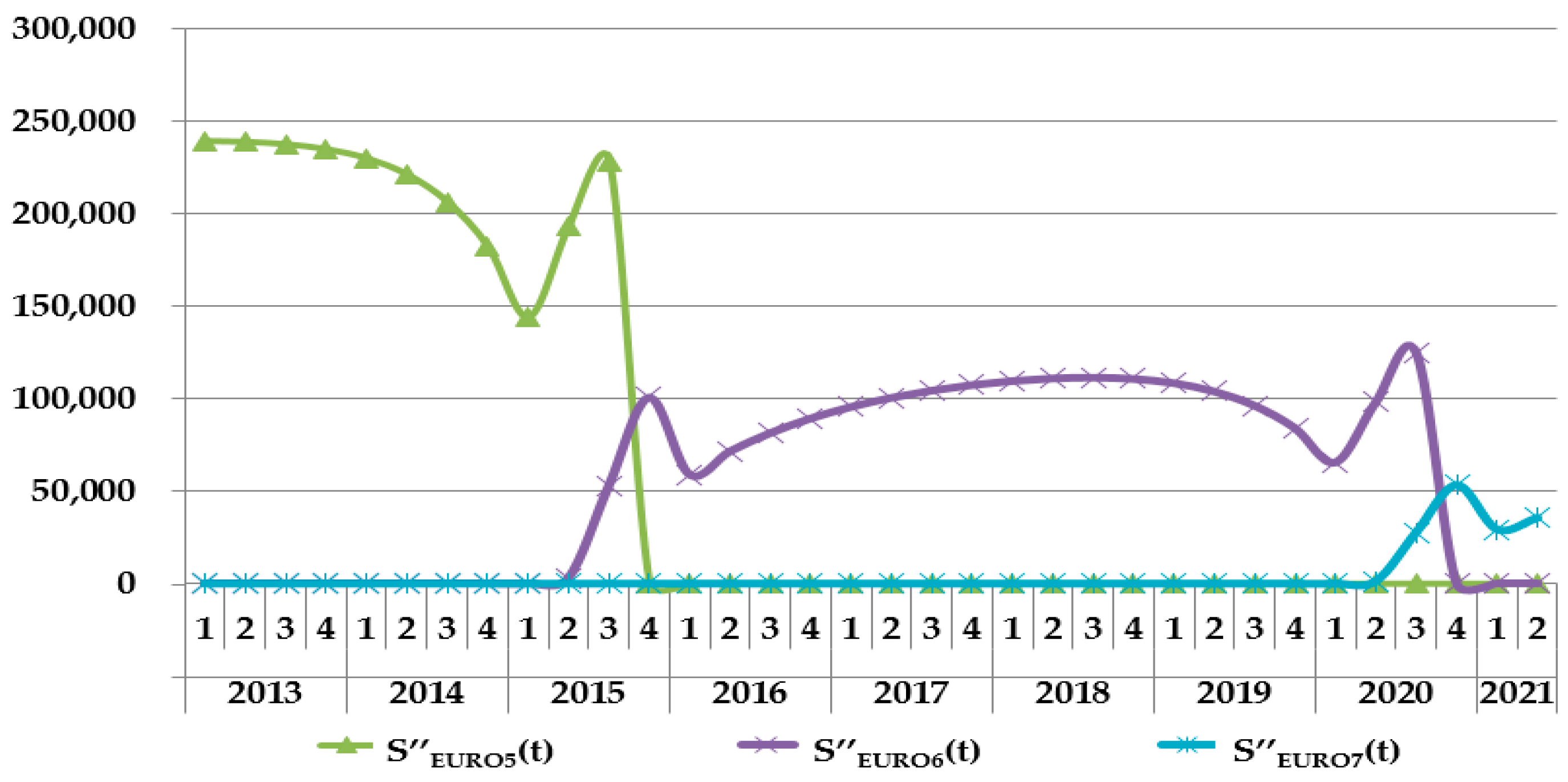
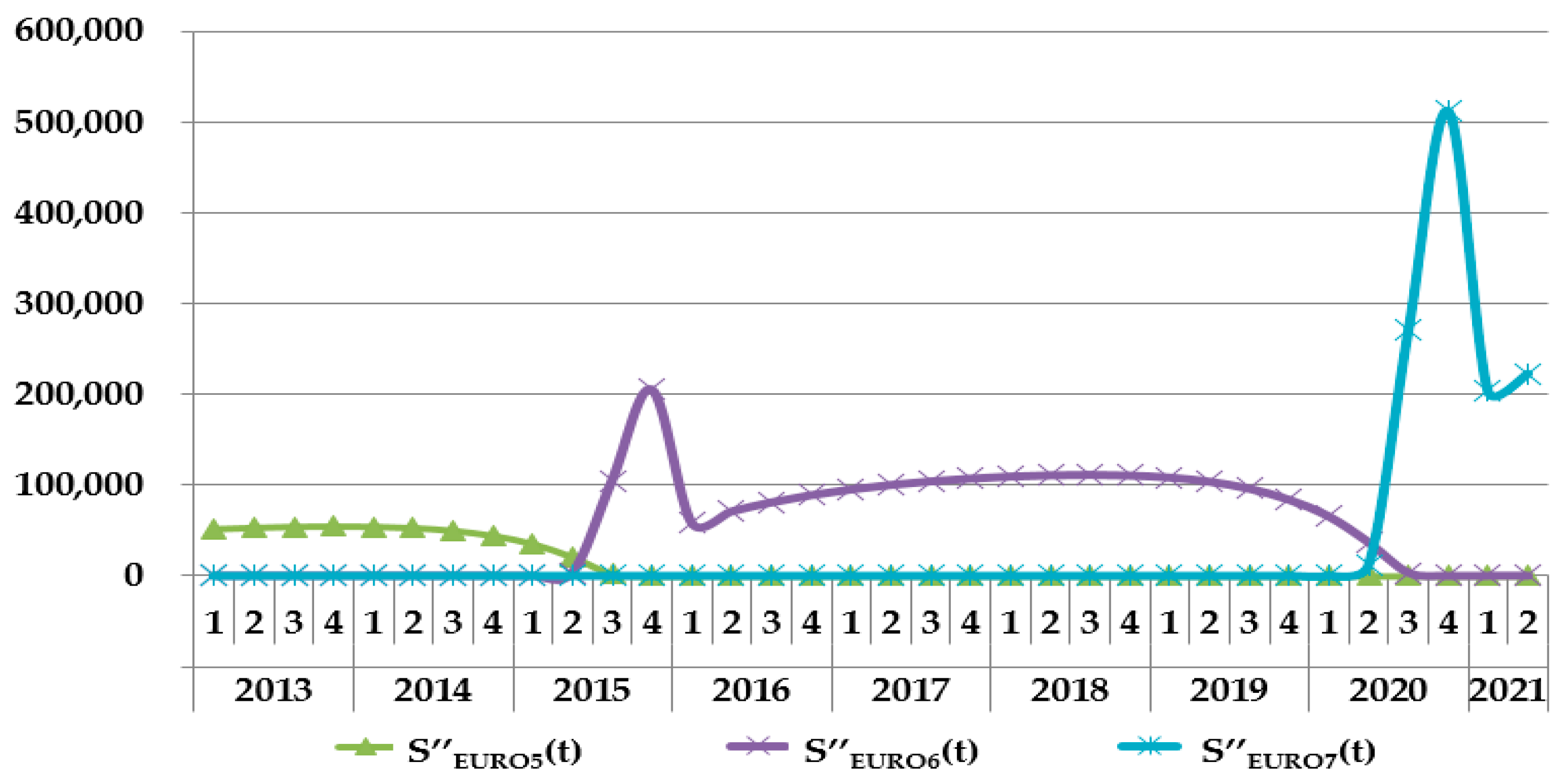
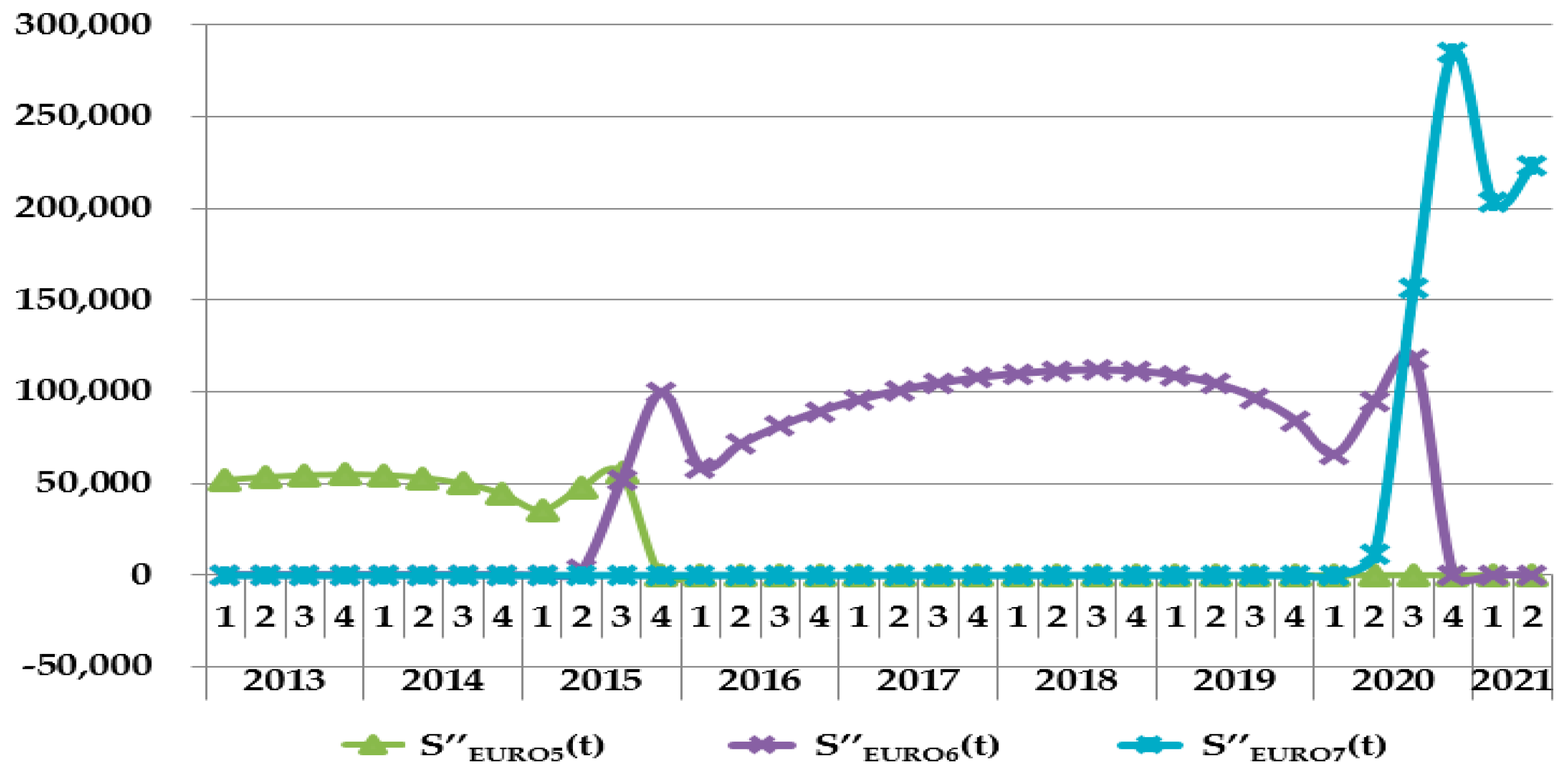
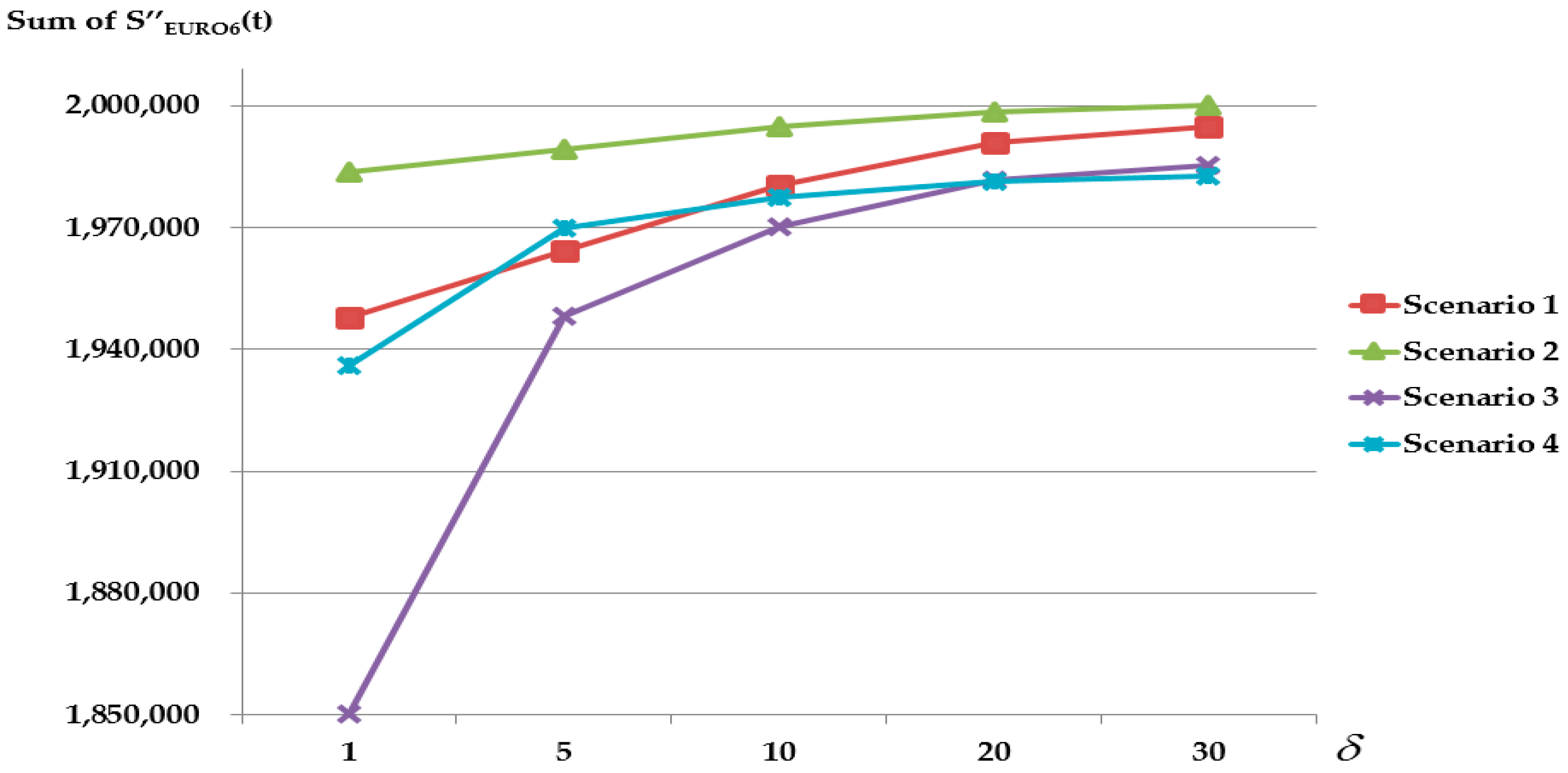
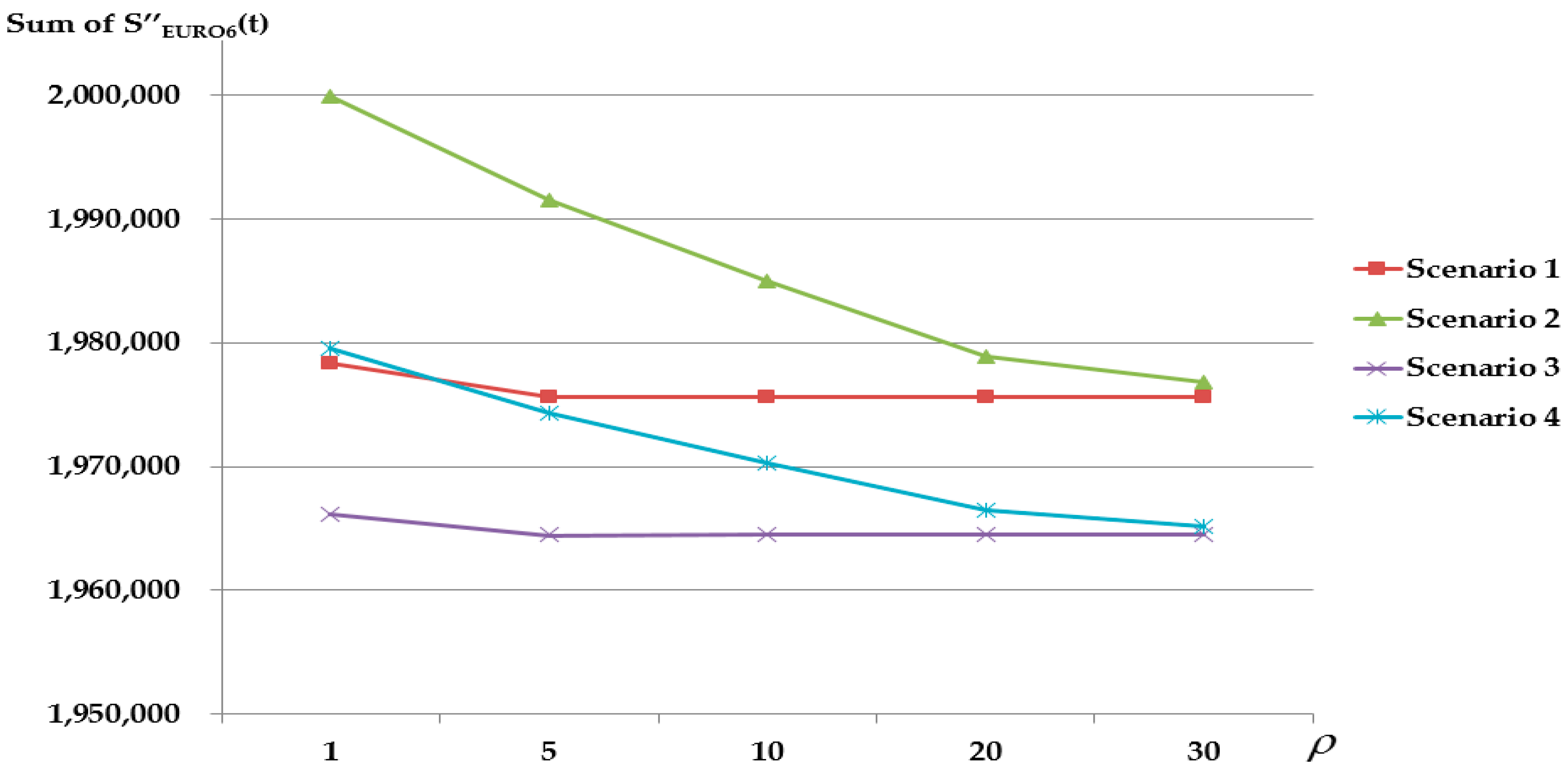
| Emission Regulation | Effective Period | NOx | NMHC | CO | HC | PM |
|---|---|---|---|---|---|---|
| EURO 3 | January 2003–December 2005 | 5.0 | - | 2.1 | 0.66 | 0.10 0.13 a |
| EURO 4 | January 2006–August 2008 | 3.5 | - | 1.5 | 0.46 | 0.02 |
| EURO 5 | September 2009–December 2013 | 2.0 | - | 1.5 | 0.46 | 0.02 |
| EURO 6 | January 2014–Present | 0.4 | - | 1.5 | 0.13 | 0.01 |
| Tier 2 b | January 2005–December 2008 | NOx + NMHC ≤ 6.6 | 3.5 | - | 0.2 | |
| Tier 3 b | January 2009–December 2014 | NOx + NMHC ≤ 4.0 | 3.5 | - | 0.2 | |
| Tier 4 b | January 2015–Present | 0.4 | 0.19 | 3.5 | - | 0.02 |
| m1 | p1 | q1 | MS1 | m2 | p2 | q2 | MS2 | m3 | p3 | q3 | MS3 | δ | Gi | ρ | |
|---|---|---|---|---|---|---|---|---|---|---|---|---|---|---|---|
| Scenario 1 | 200,000 | 0.6 | 0.5 | 0.4 | 0 | 0.3 | 0.01 | 0.2 | 0 | 0.3 | 0.01 | 0.1 | 8 | 0.10 | 4 |
| Scenario 2 | 200,000 | 0.6 | 0.5 | 0.4 | 0 | 0.3 | 0.01 | 0.2 | 0 | 0.3 | 0.01 | 0.1 | 8 | 0.90 | 4 |
| Scenario 3 | 200,000 | 0.3 | 0.01 | 0.1 | 0 | 0.3 | 0.01 | 0.2 | 0 | 0.6 | 0.5 | 0.4 | 8 | 0.10 | 4 |
| Scenario 4 | 200,000 | 0.3 | 0.01 | 0.1 | 0 | 0.3 | 0.01 | 0.2 | 0 | 0.6 | 0.5 | 0.4 | 8 | 0.90 | 4 |
© 2017 by the authors. Licensee MDPI, Basel, Switzerland. This article is an open access article distributed under the terms and conditions of the Creative Commons Attribution (CC BY) license ( http://creativecommons.org/licenses/by/4.0/).
Share and Cite
Kim, Y.S.; Han, E.J.; Sohn, S.Y. Demand Forecasting for Heavy-Duty Diesel Engines Considering Emission Regulations. Sustainability 2017, 9, 166. https://doi.org/10.3390/su9020166
Kim YS, Han EJ, Sohn SY. Demand Forecasting for Heavy-Duty Diesel Engines Considering Emission Regulations. Sustainability. 2017; 9(2):166. https://doi.org/10.3390/su9020166
Chicago/Turabian StyleKim, Yoon Seong, Eun Jin Han, and So Young Sohn. 2017. "Demand Forecasting for Heavy-Duty Diesel Engines Considering Emission Regulations" Sustainability 9, no. 2: 166. https://doi.org/10.3390/su9020166






